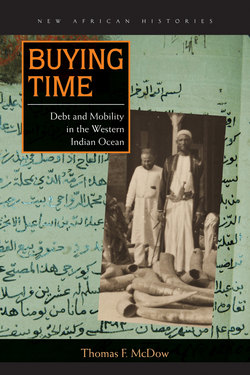Читать книгу Buying Time - Thomas F. McDow - Страница 14
На сайте Литреса книга снята с продажи.
Оглавление4
Halwa and Identity in the Western Indian Ocean World
IN THE EARLY 1840S, at the time of the Nizwa drought, Thani bin Amir al-Harthi was a humble confectioner making halwa in Oman.1 Less than twenty years later, he was one of the wealthiest traders in Kazeh, an ivory depot on the East African plateau, over four hundred miles from the Indian Ocean.2 In Africa, Thani participated in trading caravans as early as 1845, and he was thus part of the expanding commercial world of the 1840s. Thani traveled and traded extensively—from the coast to the kingdoms on the lakes—and his knowledge underlays Richard Burton’s seminal book that explained interior Africa to the English-speaking world. Thani was both participant and witness to the incorporation of upland East Africa into the Indian Ocean world.
Marginal and displaced Indian Ocean actors like Thani inadvertently connected the East African interior to a distant shore of the Indian Ocean. When people like Thani left Oman to escape instability, they often went to the East African coast. The Omani sultanate at Zanzibar tried to dominate Swahili towns, and networks of debt created new obligations to Indians, among others. Thani’s rapid reversal of fortune—from low-status confectioner to wealthy ivory trader—might suggest an effortless movement through Indian Ocean circuits. Yet the caravan trails were full of hustlers from many backgrounds, including Arabs, Swahili, Nyamwezi, and those of servile (or recently liberated) status. The mobility of these groups created new encounters among them and demonstrated the need to work out ethnic and status hierarchies. These individuals built new settlements that looked like Indian Ocean towns and spread Swahili language and culture. To understand how the newcomers did this, we first must tackle coastal chauvinism, the myth of return, and how buying time led to the growth of settlements.
Examination of towns in the interior, such as Kazeh, where Thani lived, indicates that identity distinctions among Indian Ocean migrants shaped settlement patterns and suggests the need to disaggregate groups who arrived from the Indian Ocean’s shores. Throughout the region in the nineteenth century, new mobilities created a contest between Arab newcomers and Swahili elites, even those who had been reduced to slavery. Even among people considered Arabs, extreme mobility could not outrun the taint of being baysari (a low status identity in Arabia). The process of transforming upland East Africa into an Indian Ocean world was not a grand strategy implemented from Zanzibar, Muscat, Bombay, or London. It was the result of thousands of individuals trying to make the best from limited options.
ON THE BRINK OF THE INDIAN OCEAN WORLD: UPLAND EAST AFRICA
